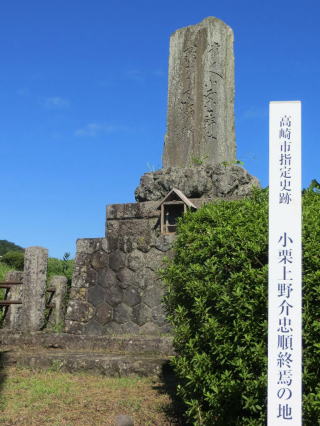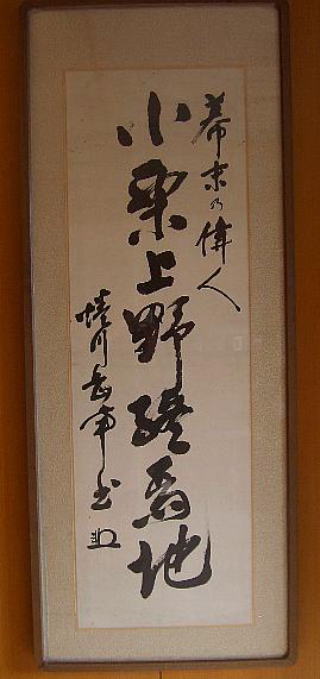| 官軍意識との戦い 復刻・蜷川新著『維新前後の政争と小栗上野介の死』 のパンフ推薦文 マツノ書店・2013平成25年10月 Fighting Against the Government Army Consciousness Recommendation on the pamphlet for "Political Struggles Before and After the Meiji Restoration and the Death of Kozukenosuke Oguri" by Arata Ninagawa, reprinted in Japanese. Matsuno Shoten, October 2013 |
|---|
官軍という言葉がある。 There is a word "Kan-gun (Loyalist Army or Government Army)." The opposite of "government" is "people," but for some reason, the opposite of "government army" is not "people's army" but "bandit army." The world is not that simple. I try not to use the word "Kan-gun" because it is an unfavorable and judgmental term. |
小栗上野介は幕府解散で勘定奉行ほか陸軍奉行などの兼職も一切解かれたので、幕府に帰農隠棲願の許可を得て家族とともに知行地の上州権田村に移り、東善寺に仮住まいをした。ところが、居宅を造り始めて二ヶ月後、やってきた西軍によって養嗣子又一及び家臣六名と共に殺されてしまった。 いま、小栗公らが斬首された烏川の水沼河原(高崎市倉渕町)に、「偉人小栗上野介罪なくして此所に斬らる」と彫られた顕彰慰霊碑が立ち、終焉の地であることを示している。碑文は『維新前後の政争と小栗上野介の死』の著者蜷川新(にながわ あらた)の書である。 Kozukenosuke Oguri was relieved of all concurrent positions of the Tokugawa Shogunate in early 1868, including that of accountant and army magistrate, upon the dissolution of the Shogunate, so he obtained permission from the Shogunate to return to farming and live in seclusion, and moved with his family to Gonda village in Jyoshu (today's Gunma Prefecture), where he was the governor. However, two months after he began to build his residence, he was killed by the Western forces (later the government army), along with his adopted son Mataichi and six of his retainers. Today, a cenotaph stands at Mizunuma Riverbank (Kurabuchi-cho, Takasaki City) on the Karasugawa River where Oguri was beheaded, with the inscription "The Great Kozukenosuke Oguri was beheaded here without sin," indicating that this was the place of his demise. The inscription was written by Arata Ninagawa, author of "Political Struggles Before and After the Meiji Restoration and the Death of Kozukenosuke Oguri." |
 顕彰慰霊碑(水沼河原) 「偉人小栗上野介 罪なくして此所に斬らる 岳南蜷川新」 Cenotaph for the memory of Kozukenosuke Oguri (at Mizunuma Riverbank) "The great Kozukenosuke Oguri was beheaded here without sin. Arata Gakunan Ninagawa" |
石碑は、斬首された河原を守って草刈りを続けてきた一村民の「このままでは小栗様が殺された場所がわからなくなってしまうから、石碑でも建てて…」という訴えを契機として、旧倉田村と烏渕(うぶち)村、両村民有志が建立計画を起し、蜷川に碑文の揮毫を依頼した。蜷川は前記碑文と、もう一枚「幕末の偉人 小栗上野終焉地」と二枚を書いて届け、村人に選択を委ねた。村人は協議の末、こちらが本当、と前者を選んで彫った。このような散文体の記念碑は珍しいといわれる。 さて、戦前は表現の自由はなかったからこういった建碑はすべて内務省に届け出ることになっていた。所轄の高崎警察署に届けると、署長山浦から「碑文に『罪なくして…斬らる』とあるが、小栗上野介を斬ったのは官軍だ。官軍は天皇様の軍隊だから罪のないものを斬るはずがない。穏やかでないから何とかしろ」とクレームがついた。別の碑文に彫り直せ、という強権指導である。 困った建設委員長市川元吉は、その窮状を蜷川に報告して対処を相談した。すると蜷川から「田中義一(総理大臣)に話をつけさせるから、待っていなさい」と返信があった。小栗道子夫人の妹はつ子が蜷川の母であり、国際法学者として活躍していた蜷川は、田中義一から国際問題に関して諮問を受け、助言をする立場にあった。田中義一からの指示があったものか間もなく署長のクレームは沙汰止みとなり、昭和7年5月5日、除幕式にこぎつけた。もう一枚は高崎市役所倉渕支所に額装で掲示されている。 One of the Gonda villagers who had been mowing the grass along the riverbank where Kozukenosuke Oguri was beheaded appealed that a stone monument be erected to mark the spot where Oguri-sama (Lord Oguri) was killed, because if nothing was done, the location would no longer be known. This prompted volunteers from the former Kurata and Ubuchi villages to plan the erection of a stone monument, and they asked Ninagawa to write the inscription around 1928. Ninagawa wrote the above inscription and another inscription, "The final resting place of Kozukenosuke Oguri, a great man at the end of the Tokugawa Shogunate," and delivered them to the villagers, who were given the choice. The villagers, after much discussion, decided that the former was the true inscription and engraved it. It is said that such a monument in prose style is rare. Before the war, there was no freedom of expression, so all such monuments had to be reported to the Ministry of Home Affairs. When they reported it to the Takasaki Police Station, Mr. Yamaura, the chief of the police station, said, "The inscription reads, '... beheaded here without sin,' but it was the government forces that slain Kozukenosuke Oguri. The government army is the army of the Emperor, so they would never slay an innocent man. It is not peaceful, so do something about it," he complained. It was a coercive instruction by the power structure to re-carve the inscription on a different one. Motokichi Ichikawa, the chairman of the Construction Committee, was troubled, and reported his predicament to Ninagawa for advice on how to deal with the situation. Ninagawa replied, "I will have Giichi Tanaka (Prime Minister) deal with the situation, so just wait and see. Ninagawa's mother, Hatsuko, was the sister of Mrs. Michiko Oguri, and Ninagawa, who was active as an international lawyer, was in a position to consult and advise Giichi Tanaka on international affairs. The chief's complaints were soon put to rest, probably under the direction of Giichi Tanaka. The unveiling ceremony of the cenotaph was held on May 5, 1932. The other writing by Ninagawa for the inscription is displayed in a frame at the Kurabuchi Branch Office of the Takasaki City Hall. |
 蜷川新の書額(倉渕支所) Calligraphy plaque by Arata Ninagawa (Kurabuchi Branch Office of Takasaki City Hall) |
署長が口にした「官軍が罪のない者を斬るはずがない」という認識と、明治新政府の対極=幕府側に居た人物は逆賊、賊軍であるとする意識は、この署長のみならず明治以後の官僚、軍人、そして明治史観で教育された多くの国民が抱いていた通念であろう。民主主義の反対だから官主主義と名づけていい官軍意識である。 しかし、世界中の軍隊で「何をしても正しい軍隊」が存在したことがかつてあっただろうか。昭和20年の敗戦でこの官軍意識は払拭されたはずであったが、じつはいまだにこの国にはびこっている。たとえば福島の原発事故も官軍意識で進めてきたことの破綻とみられる。 蜷川は国際法学者としての視点で、幕末明治の政争と明治新政府の汚点とも言うべき小栗主従殺害の理不尽を本書で鋭く指摘し、今では所在が不明な貴重な古文書を駆使して小栗公の業績と悲惨な末路を確認することに力を注ぐ。そして時に薩長政府を攻撃する言葉が激越なものとなるのは、上野介の義理の甥という身内の視点が入ることもあろうが、文中に「官軍」の語を普通に用いているように、当時の通念を無意識のうちに受け入れてしまっているジレンマからであろうか。 遠慮会釈なく痛烈に攘夷派や薩長政府の矛盾を攻撃する内容に「こんな怖い本は出せません」と幾つもの出版社から断られたすえ、説得して昭和3年に本書の刊行にこぎつけるとたちまち売り切れ、わずか2週間に4版を重ね、2年後に「続」までも出版するベストセラーとなった。 かつて村人は、館林に運ばれ首実検後に埋められていた小栗父子の首級を明治二年に盗掘し、遺体に戻している。明治政府の管理下のものを盗んだのだから永いこと(昭和30年代まで)これを秘していた。これも官軍意識との戦いといえよう。(村上泰賢) The chief's statement that "the government forces would never slay an innocent man" and his awareness that those who were on the opposite side of the new Meiji government (i.e., the Shogunate) were renegades and bandits were the common belief held not only by the chief, but also by the bureaucrats, military officers, and many citizens educated under the Meiji historical perspective. It is the opposite of democracy, and therefore, it is the consciousness of the government and military, which can be named "officialism." However, has there ever been an "army that does everything right" in the world? Although the defeat of Japan in 1945 was supposed to have dispelled this military mindset, it is still prevalent in Japan. The nuclear accident at Fukushima, for example, can be seen as a failure of the government-military mindset. Ninagawa sharply points out, from his perspective as an international lawyer, the political strife at the end of the Meiji period and the unreasonableness of the murder of Oguri, a disgrace to the new Meiji government, in this book. The fact that he sometimes attacks the Satcho government with such vehemence may be due to his personal perspective as Kozukenosuke's nephew-in-law, but it may also be due to the dilemma of unconsciously accepting the common beliefs of the time, as evidenced by his common use of the term "government forces" in the text. After being rejected by a number of publishers who said, "We can't publish such a frightening book," he persuaded them to publish the book in 1928, and it sold out instantly. It went through four editions in just two weeks and became a bestseller, with a "sequel" edition published two years later. The villagers stole the heads of Kozukenosuke Oguri and his son, which had been brought to Tatebayashi and buried after the head examination, in 1869 and returned them to the bodies. Since they had stolen something that was under the control of the Meiji government, they kept this secret for a long time (until the 1950s). This was also a battle against the government forces mindset. (Taiken Murakami) |
| 関連ページ ◆官軍意識との戦い―『会津人群像』寄稿…顕彰慰霊碑建立の苦心は明治以後の官軍意識との戦いだった ◆倉渕町の小栗上野介史蹟…水沼河原の顕彰慰霊碑・観音山の邸址・小高用水・姉妹観音 ◆「勝てば官軍」は勝者のおごり ◆お殿様のお首級(くび)迎え…小栗上野介父子の首級を盗掘・奪還した村人 |
Related Pages ◆ Fighting Against the Government Army Consciousness - Contribution to "Aizujin Gunzo": The Struggle to Build the Cenotaph was a Battle against the Government Army Consciousness after the Meiji Era. ◆ Kozukenosuke Oguri Historic Sites in Kurabuchi: Memorial Cenotaph at Mizunuma riverbank, Residence remains at Kannon-yama Mt., Shimai (Sisters) Kannon ◆ "Kateba Kangun (If you win, you are the loyalist army)" is the victor's arrogance. ◆ Welcoming Oguri's head to Tozenji Temple: The villagers who stole and retrieved the heads of Kozukenosuke Oguri and his son |
|